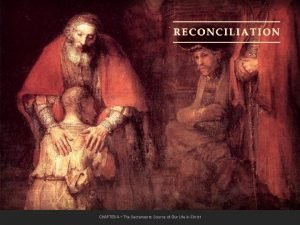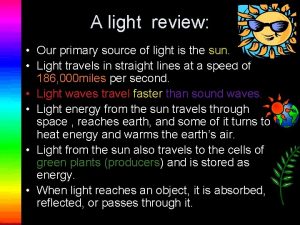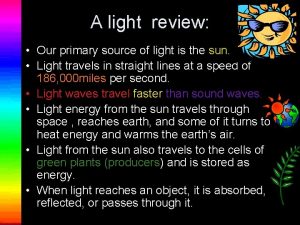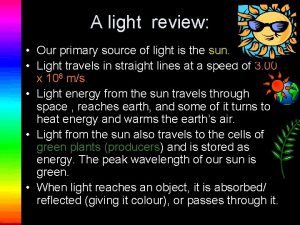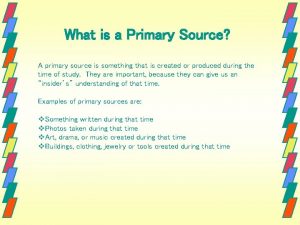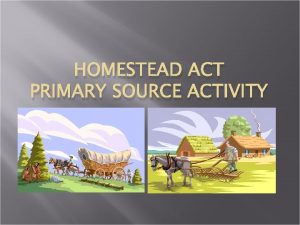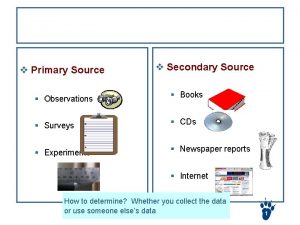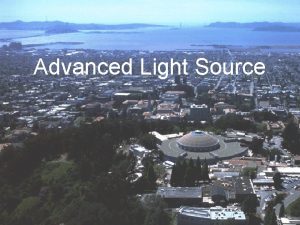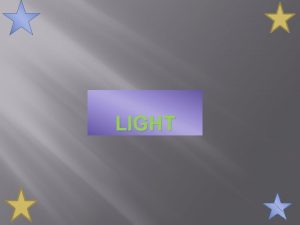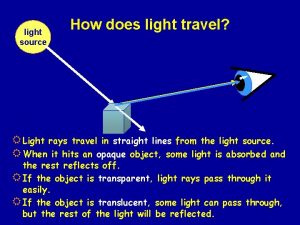LIGHT Light Our primary source of light is




















- Slides: 20

LIGHT

Light � � � Our primary source of light is the sun. Light travels in straight lines at a speed of 186, 000 miles per second. *Light waves travel faster than sound waves! Light energy from the sun travels through space , reaches earth, and some of it turns to heat energy and warms the earth’s air. Light from the sun also travels to the cells of green plants (producers) and is stored as energy. When light reaches an object, it is absorbed, reflected, or passes through it.

Sensing Light Humans have two light detectors. Do you know what they are called?

How many sources of Light can you list and explain? SUN=warms air, water, and land. Fire=provides heat, light, and cooking fuel. Lightning= Firefly= Flashlight= Light bulb= Laser beams= Optical telephone fibers= *Traffic lights= *AIMS: Primarily Physics: Light Sources Activity

“Just Passing Through: ” What happens when light strikes glass? Or waxed paper? Or a book? If light travels through an object it is =transparent If light is blocked by an object and a dark shadow is cast it is= opaque. If some light passes through but not all and a light shadow is present it is=translucent.

Transparent objects: The windows on a school bus, A clear empty glass, A clear window pane, The lenses of some eyeglasses, Clear plastic wrap, The glass on a clock, A hand lens, Colored glass… ALL of these are transparent. Yes, we can see through them because light passes through each of them.

Translucent objects Thin tissue paper, Waxed paper, Tinted car windows, Frosted glass, Clouds, All of these materials are translucent and allow some light to pass but the light cannot be clearly seen through.

Opaque objects: Heavy weight paper, Cardboard Aluminum foil, Mirror, bricks, buildings, Your eyelids and hands, Solid wood door, All of these objects are opaque because light cannot pass through them at all. They cast a dark shadow.

What is light really? Electromagnetic radiation waves Light waves are three dimensional. Light waves vibrate in all planes around a center line. The waves have high points called “crests. ” Waves also have low points called “troughs. ” *The distance from one crest to the next crest is called a “wavelength. ” *The number of waves passing a given point in one second is called the “frequency. ” wavelength

Notice the wavelength is long(Radio waves) and gets shorter (Gamma Rays)

*Electromagnetic Radiation � � Electromagnetic radiation can be described as a stream of photons. Each photon traveling in a wave-like pattern, moving at the speed of light and carrying some amount of energy. The only difference amongst radio waves, visible light, and gamma-rays is the amount of energy of the photons. Radio waves have photons with low energies. Microwaves have a little more energy than radio waves. Gammarays and cosmic rays have highest energy waves and are the deadliest.

Don’t’ forget…longest waves (radio). . to shortest waves (cosmic) *Page info from NSAT Conference 2004

Travelling Light travels from a light source in straight lines. We call these light rays. When we draw light rays, we must use a ruler, and we must always draw an arrow on the line to show the direction the light is travelling in, away from the source. Mike Turner, May 2004 Click to move on

Travelling Light passes easily through air. We say it is transparent. If light hits an opaque object, it cannot pass through. This causes a shadow, as the light rays cannot bend around the object. Some materials, eg. tracing paper, will let some light through, but we cannot see through them clearly as if we were looking through a transparent material such as glass. We say these materials are translucent. Mike Turner, May 2004 Click to move on

Why We See Things We see things when rays of light from them enter our eyes. The rays of light can travel directly into our eyes if they are from a light source such as from a light hulb. However, we see most things because they reflect some light into our eyes. Mike Turner, May 2004 Click to move on

The Eye and the Camera The eye and the camera both work in a very similar way. They each have a hole which allows light rays in, and produce an inverted (upside down) image. Rays of light travel in all directions from the head, but most of them cannot get into However, imagine a ray of light from the top of the head that is heading towards the Imagine another ray of light travelling from the bottom of the head. This ends up at t We end up with an image that is inverted. The Mike Turner, May 2004 Click to move on

Reflection and Scattering When light hits an object, some of it is reflected. How much is reflected depends on the colour (see later), and how rough or smooth the surface is. A mirror has a very smooth surface and is an extremely good reflector. Most surfaces have a rough texture, and they scatter the light in all directions. Road surafces are rough, but when the surface is wet water fills in the holes and the smooth surface becomes very shiny as it reflects a lot more light. Excellent interactive Mike Turner, May 2004 Click to move on

The Law of Reflection If we shine a ray of light at a mirror we can predict how the ray will bounce off. Mike Turner, May 2004 Click to move on

The Law of Reflection Ray box Angle of incidence I R Normal Line 90 o Angle of reflection The angle of incidence is always equal to the angle of reflection. Reflected ray Mike Turner, May 2004

How a Periscope Works periscope Mike Turner, May 2004
 Primary source of lights
Primary source of lights Ok 313
Ok 313 Primary and secondary source of light
Primary and secondary source of light Thinking language and intelligence
Thinking language and intelligence Our census our future
Our census our future Our life is what our thoughts make it
Our life is what our thoughts make it We bow our hearts we bend our knees
We bow our hearts we bend our knees Our census our future
Our census our future Our life is what our thoughts make it
Our life is what our thoughts make it Money madness by dh lawrence
Money madness by dh lawrence Our awareness of ourselves and our environment
Our awareness of ourselves and our environment Awareness of ourselves and our environment is
Awareness of ourselves and our environment is God our father christ our brother
God our father christ our brother Our future is in our hands quotes
Our future is in our hands quotes Our awareness of ourselves and our environment.
Our awareness of ourselves and our environment. Awareness of ourselves and our environment is
Awareness of ourselves and our environment is Acrament
Acrament Light light light chapter 23
Light light light chapter 23 Into the light chapter 22
Into the light chapter 22 Chapter 22
Chapter 22 Maßshirts
Maßshirts
















